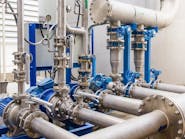No matter what industry you find yourself in, water sustainability, conservation and resiliency are essential areas that companies emphasize. While the United States used to be a water-rich country and, in many ways, still is, with recent droughts across the Midwest and changing climate patterns, many areas are seeing what used to be an abundant resource become scarce.
Water patterns are shifting. Glacial reserves are dwindling, and water runoff that traditionally fed dams and aquifers is unreliable and unpredictable. With many operations relying on local resources or utilities to meet their water needs, companies are also bumping up against the needs of local communities that require clean, reliable resources to exist against the organization's needs.
Water uncertainty is quickly becoming a more prevalent problem. Many companies, for that reason, are looking for ways to address their usage and become more thoughtful consumers of this precious resource. Ultimately, internal water policies that, even a few years ago, might have once been considered just "good PR" are quickly becoming an operational necessity.
Water and industry
While water covers 71% of the earth, most is saltwater, with just 3% of its water being fresh. Both humans and industries rely on freshwater to survive and thrive, but not all freshwater is readily available. Most, for example, is trapped in the form of ice at the poles and in glaciers; as a result, only 1% of freshwater is readily available for use across various applications.
The world withdraws 4.3 trillion cubic meters of water every year, and agricultural operations use 70%. The United States uses approximately 37% for industrial applications and 40% for agriculture.
The world over, industries rely heavily on water and have a significant water footprint across four distinct areas:
- Raw materials
- Suppliers
- Direct operations
- Product use
Industrial practices rely heavily on large amounts of water to produce and deliver products. With water reserves dwindling or becoming ever more insecure, there are instances in which industry needs and surrounding community needs conflict — and it makes good business sense to reduce usage and contamination of water supplies. It is also the right for the environment and local populations.
Water pollution is a real problem
Worldwide, 80% of water returns to the environment without being sufficiently treated. While this number is higher in low-income countries (92%), even in high-income earning states (like the U.S.), an average of 30% of water is insufficiently treated before being released.
Agricultural runoff is one of the leading causes of water pollution. Freshwater can become infected with algal blooms caused by high levels of nitrogen and phosphorus that can deplete the water of oxygen, making it undrinkable and leading to the die-off of many organisms.
However, agricultural practices are not the only culprit. Industries such as oil and gas use large amounts of water in extraction processes. When wells fail, leaks in wastewater transport occur, or when wastewater storage is poorly designed — contaminated water can re-enter the environment. In 2018, North Dakota alone reported 400 wastewater spills.
Other industries, from mining to meat processing and packaging, also have reputations for using large amounts of water during their processes and/or returning inappropriately treated wastewater into the environment. For example, in 2019, slaughterhouses in the U.S. were responsible for releasing more than 28 million pounds of phosphorus and nitrogen into various waterways. American mines are estimated to allow more than 50 million gallons of contaminated wastewater to enter waterways daily. Even technology uses unsustainable amounts of water via water-cooled data centers using approximately 3.5 million gallons of water per MW each year. Large quantities of water are needed, and to keep server racks cool requires just as much wastewater. The inefficient processes threaten to suck up much of the available fresh water in drought-prone states like California.
Companies understand the urgency of water sustainability
In 2020, more than 509 investors (with an estimated $110 trillion in assets) requested that companies disclose water security risks, impacts and actions through the CDP (formerly Carbon Disclosure Project) platform. The CDP is a worldwide disclosure system for companies, investors and cities/states/regions. These requests demonstrate investors' concerns about how water affects a company's long-term gains. A recent CDP report highlights the stakes for businesses writ large: the cost of inaction on water risks is five times the cost of action. Companies that refuse to rethink their business models or transform their approaches to adopt more water-secure technologies and practices stand to take a substantial hit to their bottom line in the years to come — and investors are beginning to notice.
Therefore, implementing water sustainability best practices is happening with a new sense of urgency. Many organizations across industrial and food processing sectors are pledging to seek ways to lower their water footprint over the next decade in the same way they have attempted to reduce their carbon footprint the decade before. The difference, however, is a sense that if inaction drags on for too long, the long- and short-term consequences could spell monetary and production disaster for any number of organizations.
Environmental, social and governance (ESG) mandates are nothing new, especially for multi-nationals and large-scale enterprises. However, water sustainability ties directly to the productivity of a business, which may be why many companies are working to lower their water footprint in a far shorter timeframe. As a result, many household brands are improving their processes to ensure they use less water or even return more water into the environment than is needed for day-to-day operations.
Net-positive water pledges are fast becoming a standard way companies promise water sustainability. As a result, many companies have pledged to substantially reduce water usage across operations or be net-positive (with many guaranteeing net-positivity by 2030).
Companies with net-positive and water reduction pledges
As more companies realize the impact — and cost — high water usage can have on their businesses and, as reserves continue to dwindle, expect even more to adopt aggressive water-saving measures across their operations.
The challenges of water quality and conservation for business
There is a general concern that it makes sense, cost-wise, to bake in water sustainability best practices.
Many companies are just starting their water conservation journey by simply tracking their usage. However, to become more water resilient, they will have to ensure the data they are capturing is correct and informative enough to provide insights into what next steps are necessary on the road to water sustainability.
While, on average, more companies are starting to track their water withdrawals, discharge and consumption, most organizations are not leveraging remote water monitoring technologies. As a result, many companies are not operating as efficiently as they could to meet ambitious sustainability goals.
By coupling remote monitoring with artificial intelligence (AI) and machine learning, companies will be able to identify trends and build models related to water quality and usage. As a result, they will be better able to calibrate processes, understand water data from various angles and make proactive decisions that conserve water, increase efficiency, improve water quality and reduce operational costs.
To do so, however, companies must transform how they capture, manage and analyze water data at every stage of their operations. Automation, analytics and remote monitoring are critical components of a meaningful water sustainability program. In the end, arming water operators with a 360-degree view of their water makes their companies more resilient in the face of global water uncertainty.
Meena Sankaran is the Founder & CEO of KETOS and is dedicated to helping transform the water industry


